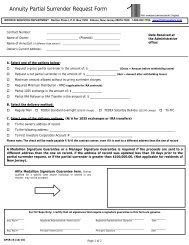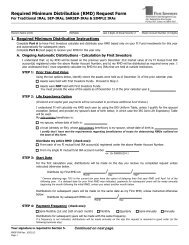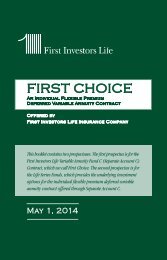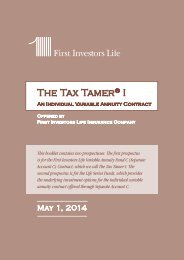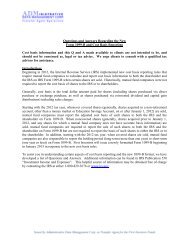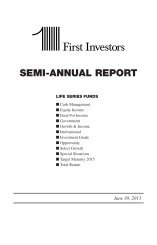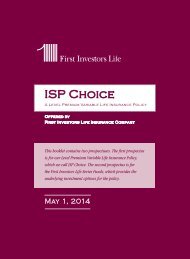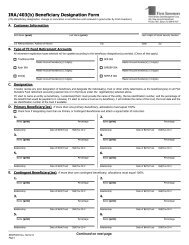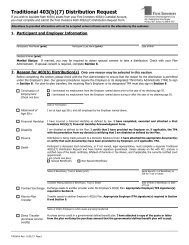Portfolio of Investments - First Investors
Portfolio of Investments - First Investors
Portfolio of Investments - First Investors
Create successful ePaper yourself
Turn your PDF publications into a flip-book with our unique Google optimized e-Paper software.
<strong>Portfolio</strong> Managers’ LetterINTERNATIONAL OPPORTUNITIES BOND FUNDDear Investor:This is the annual report for the <strong>First</strong> <strong>Investors</strong> International Opportunities BondFund for the fiscal year ended September 30, 2013. During the period, the Fund’sreturn on a net asset value basis was –0.7% for Class A shares, including capital gaindistributions <strong>of</strong> 1.3 cents per share and dividends <strong>of</strong> 29.8 cents per share. The Fund’sreturn on a net asset value basis for Advisor Class shares was –2.3% and –2.3% forInstitutional Class shares, including dividends <strong>of</strong> 15.0 cents per share on AdvisorClass shares and 14.9 cents per share on Institutional Class shares. The Advisor Classshares and Institutional Class shares commenced operations on April 1, 2013, butAdvisor Class shares were not available to the public until October 1, 2013.The strategy invests in sovereign bonds and currencies <strong>of</strong> countries in the CitigroupWorld Government Bond ex-U.S. Index as well as some non-index countries, includingthose <strong>of</strong> emerging markets. Corporate bonds <strong>of</strong> countries in the Index may bepurchased opportunistically as well. The main driver <strong>of</strong> outperformance relative tothe Index during the 12-month period involved avoiding the Japanese yen. The yenbegan falling in November 2012 as markets foresaw a sweeping victory from ShinzoAbe’s Liberal Democratic Party in elections to occur in December. Abe pledged atthe time that, if elected, he and his party would influence monetary and fiscal policyto reflate the Japanese economy. He installed a central bank chief at the head <strong>of</strong> theBank <strong>of</strong> Japan in the spring <strong>of</strong> 2013 who promised to raise inflation expectations bypursuing quantitative easing measures and purchasing financial assets. The yen felldramatically as a consequence against nearly every major world currency, so avoidingthe yen in full helped the strategy outperform the Index, which holds a more than40% exposure to the yen through Japanese government bonds exposures.Although the yen positioning dominated relative performance, the strategy’s higheryield pr<strong>of</strong>ile also generated a substantial benefit to relative performance. Longer maturityexposures in Mexico, Brazil, Australia, Hungary, South Africa, and the UnitedKingdom each contributed significantly to the strategy’s higher yield pr<strong>of</strong>ile. Derivativestransactions produced a negligible impact on performance during the period.Unrealized and realized gains from derivatives, when aggregated, produced less than10 basis points <strong>of</strong> negative impact.Market Commentary and OutlookIt has been five years since the Great Financial Crisis <strong>of</strong> 2008. Yet, any discussion <strong>of</strong>the investment outlook invariably starts with reference to this historic event as if it happenedyesterday. It is hard not to. The bankruptcy <strong>of</strong> Lehman Brothers coincided witha nearly $8 trillion collapse in U.S. household real estate values and ended a multi-decadedebt super cycle. Perhaps even more destructively, the crisis demolished confidenceand trust in the system, the outlook, policymakers, and in politicians. Confidenceis the foundation <strong>of</strong> our financial system and it will take many years to recover.32




